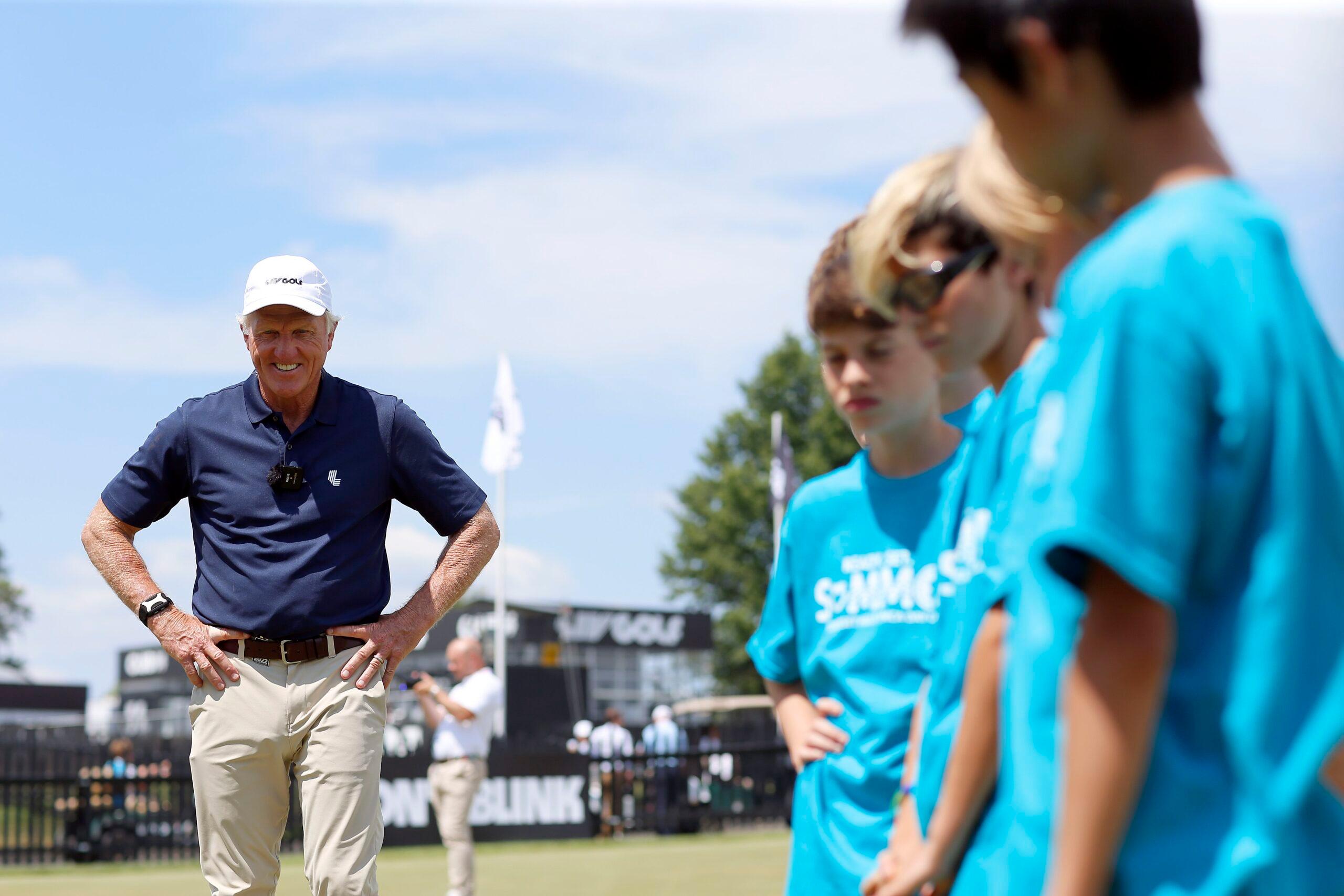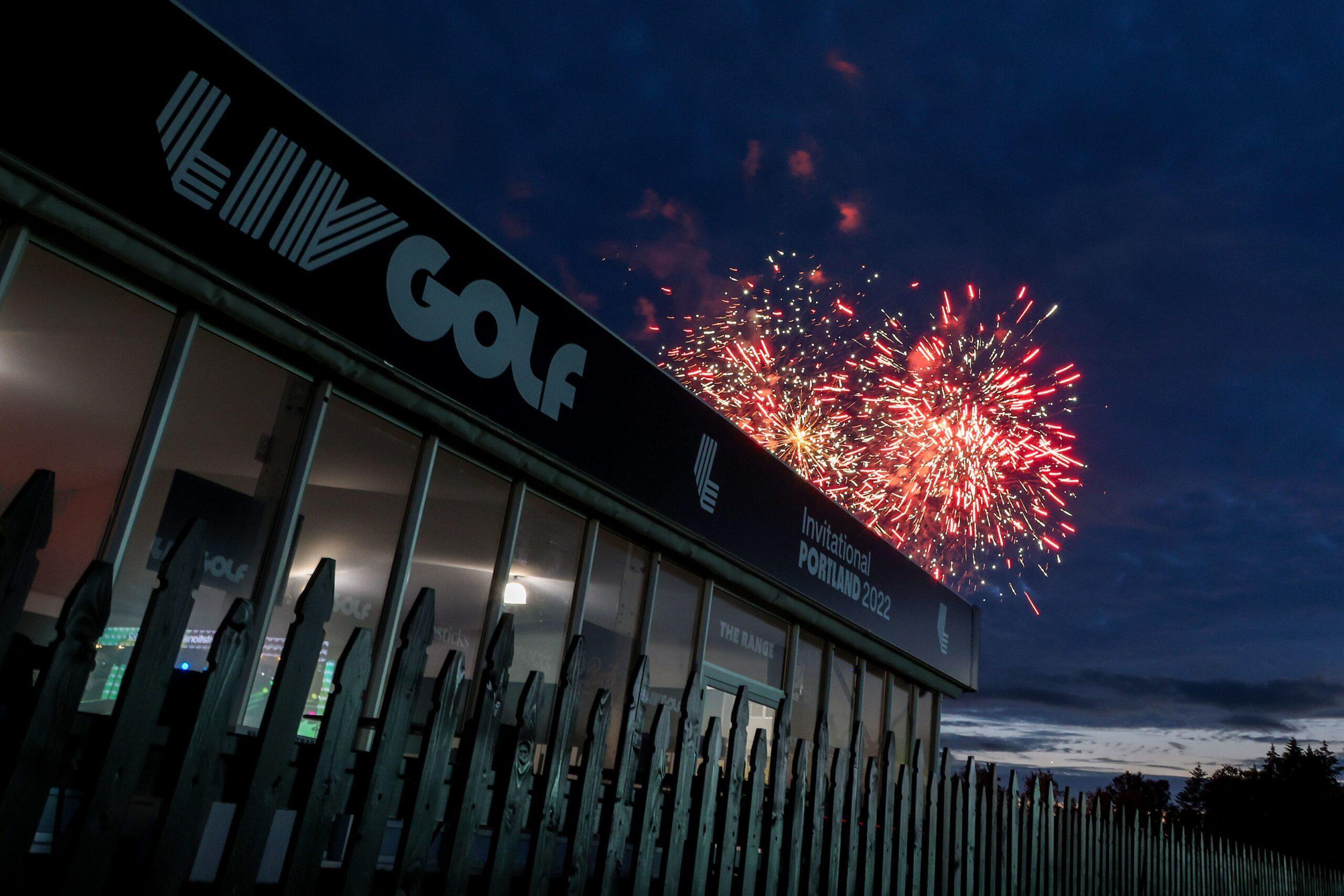Complicity and Deflection at the LIV Golf Traveling Circus
The golfers, organizers, and sponsors associated with LIV don’t care if you ask questions about the fledgling, Saudi Arabian–financed tour. But whether they’re willing to answer, and honestly account for, them is a different story.It requires a staggering amount of cognitive dissonance to set up an environmental sustainability display at a golf tournament underwritten by one of the world’s most prominent oil producers, but such is the state of affairs these days. So late last month at Pumpkin Ridge, a golf club 30 minutes west of Portland, Oregon, at the dividing line between burgeoning suburbs and rolling farmland, a man stood next to this display and used a 3-D printer to manufacture tees from recycled rubber.
His T-shirt bore the name of a company called Blue Strike Environmental, whose tagline is “Solutions for Sustainable Performance,” and which is, he said, in charge of environmental sustainability for LIV Golf, an upstart rival to the PGA Tour that’s entirely bankrolled by the public investment fund of Saudi Arabia. When I pointed out the irony of this—promoting conservation at an event backed by a country whose proposed solution to climate change is to drill for more oil—the man was not oblivious.
Later that day, I emailed the CEO of Blue Strike, Kristin Cushman, asking how this work for LIV fit in with Blue Strike’s overarching mission. Why did she think that it was appropriate to partner with one of the most controversial sporting ventures in history? Why would she even obliquely associate her company—whose website states “social justice and equity are paramount to our vision”—with a repressive government that not only has a vested interest in prolonging the world’s reliance on fossil fuels, but has been linked to the September 11 attacks and the killing of a journalist?
Cushman did not address these questions. Instead, she referred me to LIV’s media operation, which couldn’t answer for her own company’s moral choices.
That’s what it was like to attend the first LIV event on American soil: It was a litmus test in rationalization, from the sponsors to the golfers to the fans wandering the course. Some of the people gathered inside the gates of Pumpkin Ridge argued they had legitimate reasons to be there, or at least that not showing up wouldn’t improve much of anything. Take the sentiments of two limo drivers who stood outside the media center one afternoon, discussing the role authorities believe the Saudi government played in spiriting a student out of the country following a hit-and-run that killed a Portland teenager, and the decision of some Pumpkin Ridge club members to quit in protest of the tournament’s presence.
“What, you think other corporations aren’t sellouts?” one of them said.
Or take the view of many spectators wandering the course, including a couple I met from Bellingham, Washington. As we stood outside a merch tent briskly processing sales of $35 LIV Golf T-shirts, Norman and Tina Anderson told me, “Everyone’s got skeletons in their closet.”
Or take the withering cynicism of Brooks Koepka, who just a couple of weeks earlier had insisted he was tired of even hearing questions about his potential defection to LIV. Yet now that he had defected, he didn’t seem to care what he’d said before. All of that was in the rearview mirror.
So what changed?
“Just my opinion, man,” Koepka said two days before the tournament, going full-on Lebowski.
Of course, Portland was only the beginning. The very existence of LIV Golf is destined to provoke arguments that are strikingly reflective of the ongoing national divide: This week, its members head to a tournament in Bedminster, New Jersey, at a golf course bearing the name of Donald J. Trump. Trump encouraged golfers to take the money in mid-July on his social media site, Truth Social, while predicting that LIV Golf would eventually merge with the PGA Tour and insinuating that the financial rewards of joining LIV took precedence over any ethical concerns.
The more those types of nakedly capitalist sentiments echoed around Pumpkin Ridge, the more you wondered what, exactly, we were witnessing. Was LIV actually an ethical revolt in itself? Was it the birth of a white-collar uprising in what’s arguably been the most staid and conservative sport in modern history? Was LIV Golf altering the sport’s future?
Or was this nothing more than a shameless money grab for the players, and a blatant middle finger to the idea of social responsibility in sports for everyone else?

Unless you follow the minutiae of golf exhaustively, you have probably never heard of Pat Perez. Perez is 46 years old and has played more than 500 tournaments on the PGA Tour since 2002. He’s won just three of them, and yet his career earnings exceed $28 million. In a February interview, Perez responded to some LIV news and said, “I would never say anything bad about the [PGA] Tour because I’ve had an unbelievable life doing it.” He marveled at the amount of money he’d made, recalled that he’d gotten “kicked out of college,” and joked that he probably would have become a garbageman if not for professional golf.
Could the PGA Tour “throw some more [money] our way? Maybe. Yeah, not maybe,” Perez said at the time, echoing the primary talking point of Phil Mickelson, the first high-profile defector to LIV. In November, Mickelson told journalist Alan Shipnuck that he thought the PGA Tour was holding back money from its players, and that the Saudi money gave the players “leverage” against the tour. Of course, Mickelson also demolished his reputation in the same interview by declaring the Saudis to be “scary motherfuckers” in one breath and then in the next saying, “This is a once-in-a-lifetime opportunity to reshape how the PGA Tour operates.”
Perez, like many of his colleagues on the tour, was initially skeptical of Mickelson’s true intentions. “He seems to be so on the Saudi side that it’s hard to believe that he’s actually fighting” to change the tour, Perez said in February. “I don’t know what Phil’s doing. … I know he’s not speaking for me.”
And yet in late June, not even five months later, here was the same Pat Perez joining up with Mickelson and 46 other golfers who had decided that being on the Saudi side was worth, at least for Perez, a reported $10 million signing bonus. Within that time, Perez’s views of the PGA Tour’s inequities, which were once framed in the form of soft questions, had become radicalized. The new Pat Perez was no longer grateful to the PGA Tour, but angry at it. The new Pat Perez decried that he often played in tournaments with no guaranteed purse, and wondered whether the tour may have been holding back money that should have gone to the players. Perez even told the story of missing his son’s birth to play in an otherwise meaningless tournament so he could keep his place in the tour’s FedExCup standings.
“I can’t miss [the tournament],” Perez said in Portland. “I can’t get there and back without spending 150 grand on a private flight. I’m not doing that.”
As with pretty much everything else on the LIV tour, the degree of truth in this argument is based on perception. It is true that journeymen like Perez often play in more than 30 tournaments each year. There is no PGA Tour players union, so the golfers essentially live as independent contractors, even as the tour dictates their schedule. But one might also argue that a man who’s averaged more than a million dollars a year in winnings for the past two decades could afford to pay for a private flight home to witness the birth of his son. Or that he could skip a tournament here and there without maxing out his credit cards.
As the Golf Channel’s Ryan Lavner pointed out after Koepka, sitting next to Perez, brought up the knee surgery that disrupted his career in 2021 and lauded LIV for allowing him to make more money while playing less golf, LIV’s schedule for next season includes 14 events. Add the four major championships to that (whether LIV golfers are permitted to play in the majors remains very much up in the air), and it isn’t far off from Koepka’s PGA Tour schedule: He hasn’t played in more than 21 tour events since 2017, which means Koepka could essentially wind up playing the same amount of golf he has for several years.
So why do it? Is there any reason to join LIV Golf other than the money? Is defecting worth it to break the PGA Tour’s grip, to pierce the overarching power of one sports league in order to join hands with one that has morally dubious backing? (Already, the PGA Tour has made a number of changes, including dramatically raising its purses, in order to compete with LIV.)
Just a couple of hours before Perez spoke at Pumpkin Ridge, a young golfer named Matthew Wolff ended his press conference by suggesting that the money and exposure that LIV offered would allow him to broaden his legacy outside of golf and to grow the game worldwide. That somehow the money itself, no matter its source, could help create a better world. When he finished talking, I overheard one of the LIV PR flacks say to Wolff, “That was really good at the end, adding about your legacy off the golf course.”
That is how the LIV Golf experience felt: like being seduced by a carefully crafted late-night infomercial. As Lavner wrote about Portland, every golfer involved came across as a “paid actor.” Even the event’s broadcast—which aired on YouTube because, at least as of now, no network will touch this live wire—was openly propagandistic. It included constant reminders of how much fun the guys were having out there (never mind the hostage-like photos taken at the pre-tournament parties), without acknowledgment that maybe the fun didn’t actually have to do with LIV’s new format, or its insistence that LIV was “golf, but louder,” whatever that meant.
Perez, if nothing else, managed to cut through the crap. He did not launch into a long diatribe about how, by joining LIV, he could contribute much more to charities like the National Kidney Foundation, as Bryson DeChambeau had done while sitting on the podium next to Wolff earlier that day. Perez did not redirect attention to LIV’s competitive innovations, including a team format that allows a group of four players to make a wild amount of money even if they don’t play well. He admitted that this was a self-interested decision, and if people didn’t like what he’d done … well, here is his actual exchange with a reporter.
Reporter: Do you have any concerns that you are being supported by a country with a really bad human rights record?
Perez: No.
Reporter: Could you explain, please?
Perez: I don’t have any concerns. … I mean, I understand the topics you’re trying to bring up, and they’re horrible events, but I’m here to play golf. That’s my deal. I’ve got an opportunity to play golf, and that’s it.
Later that evening, Perez showed up at a party wearing a shirt adorned with likenesses of hundred-dollar bills. He played 54 holes in Portland, shot six over par, and because his team finished first, walked away with roughly $900,000. He could afford to fly home any damn way he pleased.

As Perez exited that press conference in Portland, he crossed paths with the mastermind of LIV Golf, a man who has for nearly three decades tried to find a way to break down what he thought were the draconian policies of the PGA Tour.
In 1994, Greg Norman unveiled plans for something called the World Golf Tour, a sort of global super-league with small fields of players competing internationally that would be televised by a then-fledgling Fox network. A pro golfer himself, Norman’s goal was to play more international tournaments without begging the PGA Tour for permission.
At the same time, the Federal Trade Commission was in the midst of a yearslong investigation into the PGA Tour for potentially monopolistic practices—like the rules requiring players to get approval to participate in events that conflicted with tour events, as well one that required tour approval for television appearances. Eventually, after extensive lobbying by tour commissioner Tim Finchem—who made the case that the conflicting-event rule allowed the tour to ensure that its own tournaments remained vital and could contribute to local economies and charitable organizations—the FTC backed down and decided to bring no action. And while the idea for the World Golf Tour fizzled soon after as players took Finchem’s side over Norman’s headstrong and controversial vision, it did at least briefly call attention to the PGA’s control over the sport and led the tour to take on a more global profile through its World Golf Championships series.
These issues largely fell away for nearly 30 years, until 2021, when Norman raised them again. That year, Norman was named CEO of an upstart, Saudi-financed organization known as LIV Golf Investments, which laid out a vision for a world golf tour that would compete with the PGA. In an interview with Golf Digest last November, Norman insisted he’d made multiple trips to Saudi Arabia and was “so impressed” with the country’s progress on women’s rights. He’s also gone out of his way to downplay some of the most horrific acts linked to the Saudi government. “Look, we’ve all made mistakes,” Norman said in May, when asked about the killing of journalist and dissident Jamal Khashoggi, “and you just want to learn by those mistakes and how you can correct them going forward.”
Appalling statements like that didn’t prevent Norman from reeling in Mickelson, who was willing to napalm his legacy as a lovable dude and shed his sponsorship deals to make an absurd amount of money playing out the last threads of his competitive golf career. And as other golfers heard from defectors like Mickelson, the more momentum built, despite the source of the money. Their lives may have been good as they were, but why couldn’t they be even better? Why did the tour exert such control over them (in ways that many other professional sports leagues exert over their athletes, but that wasn’t the point)? What was wrong with making more money playing golf, before their ability to play at a high level faded away due to age, injuries, or a lack of motivation?
As Norman’s grudges against the tour have once again manifested, so too have questions about the tour’s anticompetitive behavior: The Wall Street Journal recently reported that the Justice Department is investigating the PGA Tour over potential antitrust violations. “I think these [golfers] felt like, well, they’re independent contractors, and nobody should be telling them when and where and how they should play,” says Keith Lambrecht, the director of the sports management program at Loyola University Chicago, who has authored multiple papers about golf spectatorship. “Or for how much money.”
Is it possible to simultaneously fight against unfair working conditions and accept money from a country that nonpartisan observers label as decidedly “not free”? Could what’s happening now actually, as many LIV golfers have argued, lead to a better future for the sport?
Here is another excerpt from that Pumpkin Ridge press conference:
Reporter: Brooks, to your point about we’re trying to grow the game, are you concerned that you might be alienating fans given that you’re associating with a country that does have a horrific track record on human rights?
Brooks Koepka: Well, considering the fact that there’s more golf on TV, I mean, yeah, that’s going to grow the game, right? More people watching. I mean—
Reporter: I don’t know. I mean, do people want to watch if you’re associated with this type—
Pat Perez: We haven’t asked them. We don’t know. You ask them. We haven’t asked them. Go ask them.

There are so many questions about the LIV tour that have yet to be answered, and it doesn’t seem that anyone involved wants to answer them. Particularly corporate America. There was nothing stranger than spending a couple of days at a golf tournament with no prominent displays of corporate sponsorship. When I did witness a corporate presence, like a Ping or a TaylorMade logo on a golf bag or a hat, it was a jarring reminder of the odd ethical purgatory that had been constructed behind the gates at Pumpkin Ridge. How, for instance, did the equipment manufacturers feel about players bearing their logos? Did they care? Were they just hoping no one would notice?
While a few companies, like Rocket Mortgage, Royal Bank of Canada, and UPS, have dropped LIV golfers from their deals, a number of others haven’t said much of anything. “We have no comment at this time,” a TaylorMade spokesperson told me. Asked about the fact that TaylorMade golf balls were being sold at the LIV tour’s merchandise tent, the spokesperson said, “Those were not purchased through TaylorMade.” An Adidas representative said they’ve issued no statements of any kind about LIV Golf, and messages to representatives of Ping and Acushnet (the parent company of Titleist) received no response.
“Brand associations are building blocks for brand equity,” says Bettina Cornwell, head of the department of marketing at the University of Oregon. The decision of golfers to join LIV, Cornwell says, may not directly affect their endorsement contracts, but “for brands expressing support for human rights, to associate with the LIV tour would damage brand equity.”
In other words, what company wants to directly associate itself with a government that “restricts almost all political rights and civil liberties”? Isn’t it easier just to pretend that it’s not happening at all?
Take Koepka, who wore a Nike hat in his press conference and a Nike hat on the course, a byproduct of his longtime endorsement deal with the company. Nike’s headquarters are roughly 15 miles from Pumpkin Ridge, but I couldn’t find any official statement from Nike about LIV’s presence in its own backyard. I couldn’t even find any information on whether Koepka still has a deal with Nike at all. (An email to Nike’s media relations department received no response.)
“You have to think about what harms would come from doing this action,” says Shawn Klein, who writes a blog called The Sports Ethicist and teaches philosophy at Arizona State University. “And what harms would come from not doing this action.”
Klein’s comments get at the larger question related to those harms: How much distance can the LIV golfers really put between themselves and the Saudi regime? They could try to argue, Klein says, that because Saudi Arabia is not directly managing the LIV tour, the country is not directly restricting players’ speech, even though the whole thing feels like a propagandistic exercise. “Are they going to treat women better if Phil Mickelson doesn’t compete on the LIV tour?” Klein says. “The more daylight there is between the LIV tour and the Saudis, the more you can make a little moral space.”
But there is still that glaring issue of the money. And the idea raised by DeChambeau—that somehow this would allow him to pour more cash into his local community, and to give more to charity—brings up a serious ethical quandary. “If he’s saying, ‘Look, this is dirty money, so I’ll play and take it and give it to a good cause,’ I’m a little uncomfortable with that,” Klein says. “If you think the money’s dirty, you shouldn’t take it in the first place.”
(A spokesperson for the National Kidney Foundation said it has an ongoing relationship with DeChambeau’s charitable foundation; as for taking money he might have earned from LIV Golf, and whether it vets the sources of its donations, the spokesperson said, “A policy of vetting the source of a foundation’s donation, like you describe, would be labor intensive and cost prohibitive to enforce for any charity. We would need to divert badly needed donated funds … to investigate and track the source of every dollar given to us by every foundation.”)
Perhaps that’s why it’s easier for the golfers on the LIV tour—and the PR operation that runs it, and the companies tiptoeing around it—to avoid confronting these issues at all. That’s why it’s easier for the players to frame themselves as nothing more than golfers seeking a larger paycheck for less work. That’s their deal, and they’re happy with it, even if you aren’t.
The galleries at Pumpkin Ridge weren’t overwhelming, but they weren’t nonexistent, either. People like Norman and Tina Anderson, the fans I spoke to, didn’t seem bothered by any of this. When one of the least-liked players in pro golf, Patrick Reed, suddenly joked that he’s considering moving to Portland—and when another LIV player, Talor Gooch, unironically compared the atmosphere at Pumpkin Ridge to the prestige of a Ryder Cup event—you started to wonder whether this infomercial was even more powerful than you realized.
After Portland, every golfer on the LIV tour got nearly a month off before the next tournament, unless they qualified for the Open Championship. They could fly home, relax, and revel in their wealth. With every tournament, and with every PGA Tour defection, LIV establishes itself that much more within the consciousness of fans; last week, European Ryder Cup captain Henrik Stenson joined LIV and forfeited his captaincy in the process. And the question remains as to whether LIV will succeed in spite of the ethical morass it represents; will there come a point when it attracts enough talent and gathers enough power that sponsors and TV networks are willing to overlook these fundamental concerns?
The LIV traveling circus will land in Boston and Chicago in September; it will operate in Bangkok; Jeddah, Saudi Arabia; and Miami (at another Trump-branded course) in October. But before all of that, a tournament in New Jersey awaits. A tournament to be played at the Trump National Golf Club in Bedminster, at the same course that was supposed to host the 2022 PGA Championship before the PGA of America chose to move it after the events of January 6, 2020. A tournament that those same 9/11 survivors who protested in Portland are already pleading for Trump to reject, even as he digs in deeper with his support of Norman and the executives of LIV—referring to them as “very fine people” who made a calculated decision to take the money now, while they could, and to hell with the consequences.
The way they see it, all those questions about ethics and morality remain yours to ask, but not theirs to answer.
Michael Weinreb is a freelance writer and the author of four books.
